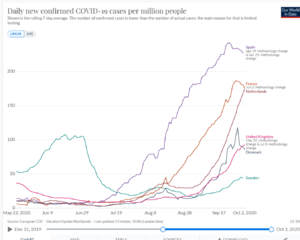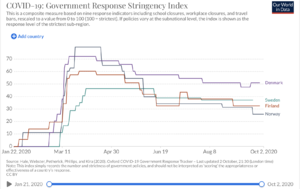Det skal jeg gjøre, men vil gjerne vite hva du legger i begrepet flokkimmun før jeg begynner.Men du påstod nylig at Sverige var på vei inn maratonporten og så godt som flokkimmune allerede, men nå øker smitten i Sveriges mest flokkimmune områder. Hvordan forklarer du det?
Medisin og helse Corona
- Trådstarter Disqutabel
- Startdato
Diskusjonstråd Se tråd i gallerivisning
-
Vart femte cancerfall i Stockholm oupptäckt
Regionalt cancercentrum i Stockholm vädjar till stockholmare att vara uppmärksamma på cancersymtom och söka vård. Trots förhoppningen att fler skulle komma tillwww.aftonbladet.se
Også vil jeg også minne deg på at det ikke er Norge vi skal vurdere Svenskenes strategi mot.Det skal jeg gjøre, men vil gjerne vite hva du legger i begrepet flokkimmun før jeg begynner.
Jeg hører den norske regjeringen si at vi er et av de mest åpne samfunnene i Europa - vel vi har langt strengere tiltak enn Sverige.

Jeg legger det samme som du gjorde. At Sverige møtte Norge på vei inn og ut av stadion og at Sverige trolig var ferdig med Covid i juli.Det skal jeg gjøre, men vil gjerne vite hva du legger i begrepet flokkimmun før jeg begynner.
OK, da referer jeg til pressekonferansen de holdt på torsdag, hvor helsemyndigheten sa Corona ikke påvirker kapasiteten i helsevesenet og at Corona nå er en av mange andre sykdommer som behandles. Og slik har det vært siden juli.Jeg legger det samme som du gjorde. At Sverige møtte Norge på vei inn og ut av stadion og at Sverige trolig var ferdig med Covid i juli.
Er det derfor du utelater Norge fra grafen?Også vil jeg også minne deg på at det ikke er Norge vi skal vurdere Svenskenes strategi mot.
Jeg hører den norske regjeringen si at vi er et av de mest åpne samfunnene i Europa - vel vi har langt strengere tiltak enn Sverige.
Dette med langt strengere tiltak i Norge enn i Sverige er interessant. Hva bygger du det på? Det er fortsatt ikke slik Our World in Data ser det, og da har de tydeligvis ikke fått med seg den lille innstrammingen som kom for Sveriges del denne uken. Du viste nettopp en annen graf fra OWiD, så hvorfor ikke denne?

 Fløy fra Oslo til Finnmark mandag 21.09. Traff en tidligere kollega og pratet litt med ham. Han satt på raden foran oss.
Fløy fra Oslo til Finnmark mandag 21.09. Traff en tidligere kollega og pratet litt med ham. Han satt på raden foran oss.
Mandag 28.09 ringer som tidligere sagt smittevernoverlegen. "noen" fra flyet hadde blitt syk! Ut fra det man kan lese i avisene
er det ca 10 stk på denne flighten som hadde blitt satt i karantene. Hvem som "karanteneres" er det FHi som bestemmer. Kona som
satt på 3a ble hanket inn, jeg som satt på 3c visste ikke den kommunale smittevernlegen noe om. Jeg sto ikke på lista. Snodig??
Men kollegaen satt på 2a, så etter at de små grå som Hercule Poirot stadig referer til hadde fått jobbe, fikk vi ideen å kontakte min
kollega. Svarer ikke på telefonen så jeg sender en melding og spør om han hadde blitt kontaktet. Svaret kom ganske fort: "Fårete smilefjes"
og teksten "Det var meg!" Da forsto jeg faktisk enda mindre av at ikke jeg var på listen over mulig smittede. Ut fra belegget på flyet og det
som sto i avisen har de varslet seteraden han satt på og den foran og den bak. Jeg pratet en god stund med ham mens vi ventet på
bagasjen og da uten munnbind. Men meteren holdt vi med god margin. Nå er karantenetiden ute og jeg har ikke følt noen symptomer. Han
beskrev det som en lett forkjølelse, men han hadde mistet smakssansen. Er viruset i ferd med å bli "snillere"? Evt, er de som kun får lette
plager mindre smittsomme?
Og ja helt til slutt, Han hadde staret dagen tidlig, med morrafly til OSL for å nå første nordover. Han kom fra Arendal!
Dette har du akkurat kverulert på.Er det derfor du utelater Norge fra grafen?
Dette med langt strengere tiltak i Norge enn i Sverige er interessant. Hva bygger du det på? Det er fortsatt ikke slik Our World in Data ser det, og da har de tydeligvis ikke fått med seg den lille innstrammingen som kom for Sveriges del denne uken.
Vis vedlegget 666015

Hva ble strengere i Sverige denne uken..?Jeg mener du nettopp forklarte noe om strengere regler for isolasjon av husstandsmedlemmer ved påvist smitte, eller leste jeg helt feil?
Ellers er jo den almenne definisjonen av flokkimmunitet at R<1 uten sosial distansering eller andre spesielle tiltak, og det var vel de som mente at flokkimmunitet inntrådte i Stockholm i april-mai en gang, så jeg er også litt nysgjerrig på hvordan du forklarer økningen der den siste måneden. Du må gjerne kalle det kverulering, men jeg er litt interessert i å høre hvordan de brikkene passer sammen i ditt hode.
Jeg skjønner at du er veldig opptatt av å kverulere med alt jeg sier.Jeg mener du nettopp forklarte noe om strengere regler for isolasjon av husstandsmedlemmer ved påvist smitte, eller leste jeg helt feil?
Ellers er jo den almenne definisjonen av flokkimmunitet at R<1 uten sosial distansering eller andre spesielle tiltak, og det var vel de som mente at flokkimmunitet inntrådte i Stockholm i april-mai en gang, så jeg er også litt nysgjerrig på hvordan du forklarer økningen der den siste måneden. Du må gjerne kalle det kverulering, men jeg er litt interessert i å høre hvordan de brikkene passer sammen i ditt hode.
Vi bor i Norge og du påberoper deg hele tiden lokalkunnskap om Sverige. Hvorfor må du bruke en internasjonal samleside for å finne argumenter. Men for all del - gi oss tallene som grafen baserer seg på - så skal jeg gi deg rett om det stemmer. Hvis ikke så er du bare kverulant.
Når det gjelder nye regler i Sverige så skrev jeg om det i går:
Men når jeg utfordret deg forrige gang du kom med denne tullete grafen (Det var på mandag), så presterte du jo å hevde at det var strengere karantenregler i Sverige:Det blir nå innført litt restriksjoner for de som bor sammen med en som får bekreftet smittet. Dette er det lokale myndigheter som bestemmer. Og da er det i tilfelle:
- Skal holde seg hjemme i 7 dager
- Gjelder ikke barn - da de vurderer at det er viktigere at barna går på skolen
- Det er kun en oppfordring - altså ingen vil bli straffet for å bryte en slik oppfordring.
- Man skal på ingen måte "sette seg selv i slik karantene" det er kun hvis du blir kontaktet av helsevesenet.
Og selv om jeg mener det er en liten innstramming - så er det ifølge kverulantlogikken din åpenbart en lettelse - for hvis det var strengere før, så kan det jo ikke være det nå? Eller mener du at det som ble presentert på pressekonferansen på torsdag er strengere enn i Norge..?Gjør jeg? Jeg mener da bestemt at jeg hardnakket hevder at det i praksis kommer ut ganske likt. Men bare for å nevne noe:
• 14 dagers varighet på instruksjoner for hushållsmedlemmer (ikke 10)
Og det stråmann argumentet ditt om flokkimmunitet kan du dele med fela, KjellR, Polka og 65 finger - jeg gidder ikke å svare på det flere ganger. Det er veldig lite dramatikk rundt Corona i Sverige i forhold til her i Norge.
Tåkefyrstesvar...OK, da referer jeg til pressekonferansen de holdt på torsdag, hvor helsemyndigheten sa Corona ikke påvirker kapasiteten i helsevesenet og at Corona nå er en av mange andre sykdommer som behandles. Og slik har det vært siden juli.
Ikke så rart - de er jo immune hele gjengen snart. Da kan man jo slappe av...Det er veldig lite dramatikk rundt Corona i Sverige i forhold til her i Norge.
Selv befinner jeg meg i Sverige for tiden. Det er nok en tendens til at jeg blir uvanlig interessert i hvordan smittesituasjonen og regelverket er i Sverige når jeg har tenkt meg hit, selv om du tror alt handler om å kverulere med deg. Sist du nektet å tro på OWiD’s graf fikk du en liste på fem-seks punkter som vitterlig er strengere her enn i Norge. Det ser ikke ut til å ha gjort noe særlig inntrykk. Når var du selv sist i Sverige for å se situasjonen med egne øyne? Eller sitter du bare i Bergen og synser?Vi bor i Norge og du påberoper deg hele tiden lokalkunnskap om Sverige.
[...]
Det er veldig lite dramatikk rundt Corona i Sverige i forhold til her i Norge.
Jeg ser også at du nekter å svare på hvordan smitten i Stockholm kan øke så mye som den gjør enda du har hevdet «flokkimmunitet» siden april. Det er bare to måter det kan skje på: Enten har det aldri vært noen flokkimmunitet der ettersom antall smittede er langt lavere enn du tror, eller så har mange av de som ble smittet i mars-april nå blitt mottakelige igjen og flokkimmuniteten har fordampet. Hvilken er mest sannsynlig, tror du?
De punktene kommenterte jeg på mandag, og nei de gjorde ikke noe særlig inntrykk. Jeg siterte jo et av de i innlegget over.Sist du nektet å tro på OWiD’s graf fikk du en liste på fem-seks punkter som vitterlig er strengere her enn i Norge. Det ser ikke ut til å ha gjort noe særlig inntrykk.
Forrige gang du kom med OWI sin graf lastet jeg ned datagrunnlaget og fant hvor svenskene scoret høyere og det stemte i liten grad med virkelighet. Men du kan gjerne gjøre det igjen - så kan vi ta en debatt på fakta, men det er du nok ikke så interessert i.
I din verden er det sikkert bare to måter det kan skje på. I den virkelige verden så er det vel ikke mer komplisert enn at R0 har økt fordi folk er mindre flinke med smittevernregler og at folk lever tettere på hverandre nå som høsten kommer, folk trekker inn, folk er mer tilbake på jobb, skolen har begynt osv.Jeg ser også at du nekter å svare på hvordan smitten i Stockholm kan øke så mye som den gjør enda du har hevdet «flokkimmunitet» siden april. Det er bare to måter det kan skje på: Enten har det aldri vært noen flokkimmunitet der ettersom antall smittede er langt lavere enn du tror, eller så har mange av de som ble smittet i mars-april nå blitt mottakelige igjen og flokkimmuniteten har fordampet. Hvilken er mest sannsynlig, tror du?Det er vel ganske lite interessant å diskuterer ett begrep som "flokkimmunitet" når man ikke har en felles definisjon av hva begrepet egentlig betyr? Kanskje de som benytter dette begrepet hele tiden først kunne klargjøre hva deres definisjon av begrepet er?Eller ikke. Catfights er jo alltid morsomt å observere.
Kanskje vi heller kan bruke tallknuserne til noe fornuftig? Som å gi oss en oversikt over hvor mange av de døde i både Sverige og Norge var forventet døde innen de neste et til to år, slik at diskusjonen kan dreie seg om tapte leveår - kontra bruk av penger og veie det opp mot følger av ulike tiltak.Kommer av en eller annen grunn på denne historien. Min nevø sitter bak i bilen og ser et dyr. "Se, en gris". "Nei Marius, det er en sau". "Gris!". Når de kommer nærmere: "Nå ser du at det er en sau?" "Men jeg VIL at det skal være en gris!"
Helt enig!Eller ikke. Catfights er jo alltid morsomt å observere.
Kanskje vi heller kan bruke tallknuserne til noe fornuftig? Som å gi oss en oversikt over hvor mange av de døde i både Sverige og Norge var forventet døde innen de neste et til to år, slik at diskusjonen kan dreie seg om tapte leveår - kontra bruk av penger og veie det opp mot følger av ulike tiltak.
Flokkimmunitet beskriver situasjonen når så mange medlemmer av «flokken» er immune mot en sykdom at denne ikke lenger sprer seg. Mottakelige individer beskyttes gjennom flokkens immunitet. Hvis ett individ er smittet vil smitten sannsynligvis ikke komme videre til andre mottakelige individer. Matematisk er dette en situasjon hvor Re<1 for et virus med R0>1.Det er vel ganske lite interessant å diskuterer ett begrep som "flokkimmunitet" når man ikke har en felles definisjon av hva begrepet egentlig betyr? Kanskje de som benytter dette begrepet hele tiden først kunne klargjøre hva deres definisjon av begrepet er?

Herd immunity and COVID-19: What you need to know
Get the facts about coronavirus and herd immunity.www.mayoclinic.org
Definisjonen er ikke spesielt vanskelig, men det er verre å skille mellom hva som er «naturlig» flokkimmunitet som følge av at tilstrekkelig mange har blitt smittet og immune, og «sosial» flokkimmunitet som følge av at tilstrekkelig mange følger myndighetenes råd om smittevern etc. Effekten på spredningen av viruset blir nokså lik.Herd immunity occurs when a large portion of a community (the herd) becomes immune to a disease, making the spread of disease from person to person unlikely. As a result, the whole community becomes protected — not just those who are immune.Sist redigert:
Det vil altså være mulig at det dukker opp smitte selv om det foreligger "flokkimmunitet", eller er dette feil tolket? Men smitten vil ikke spre seg videre? Eller vil den spre seg, men betydelig saktere? Eventuelt hvor mye saktere vil smitte skje? Eller mener du at smitten vil dø ut automatisk etter at en person er blitt smittet, fordi alle andre er immune? Jeg forstår hva du skriver her, men definisjonen virker ikke veldig presis på meg.Flokkimmunitet beskriver situasjonen når så mange medlemmer av «flokken» er immune mot en sykdom at denne ikke lenger sprer seg. Mottakelige individer beskyttes gjennom flokkens immunitet. Hvis ett individ er smittet vil smitten sannsynligvis ikke komme videre til andre mottakelige individer.

Herd immunity and COVID-19: What you need to know
Get the facts about coronavirus and herd immunity.www.mayoclinic.org
Definisjonen er ikke spesielt vanskelig, men det er verre å skille mellom hva som er «naturlig» flokkimmunitet som følge av at tilstrekkelig mange har blitt smittet og immune, og «sosial» flokkimmunitet som følge av at tilstrekkelig mange følger myndighetenes råd om smittevern etc. Effekten på spredningen av viruset blir nokså lik.Definisjonen er ganske presis. Jeg la til en setning om Re<1 i innlegget over, dvs at hver smittede sprer smitten til mindre enn en ny mottakelig person. Små utbrudd kan oppstå, men de slukner ut av seg selv fordi det er så få mottakelige individer i flokken og lite sannsynlig at et smittet individ kommer i kontakt med et mottakelig individ.
I en flokk som ikke tilpasser adferden ved sosial distansering etc kan man regne ut eksakt hvor terskelen for flokkimmunitet går ut fra virusets smittsomhet R0. For korona er R0 et sted rundt 3-4, så antall syke vil øke til et sted mellom 50 og 60 % har vært smittet, også begynne å avta fordi spredningstallet Re har bikket under 1,0. Etter det vil antall nye smittede gradvis avta mot null og totalt antall smittede flate ut et sted rundt 80 %, uten at jeg har finregnet på de tallene.
Men mennesker tilpasser adferd, holder avstand, vasker hender, går i karantene osv. Som vi har sett har smitteverntiltakene i Norge fått ned spredningstallet til mindre enn 1,0 med bare 1,6 % av befolkningen smittet. Formen på kurven blir den samme som ved naturlig immunitet, bare med langt færre smittede, men det er da en risiko for at kurven spretter opp igjen hvis folk slapper av på smitteverntiltakene.
Kjernen i diskusjonen mellom OMF og meg er hvorvidt utviklingen i Sverige også reflekterer at folk har tilpasset adferd eller om det er en «naturlig» flokkimmunitet som følge av smitte. Jeg mener at det også er et resultat av smitteverntiltak, som riktignok ble satt inn senere og mer halvhjertet enn i Norge, men til gjengjeld har blitt opprettholdt på omtrent samme nivå frem til nå. Den oppblussingen vi har sett i både Norge og Sverige de siste ukene tyder ikke på at Sverige har noen større grad av biologisk flokkimmunitet enn Norge. Som Stockholms smittevernmyndighet også sier handler dette om å følge myndighetenes råd og praktisere smittevern for å holde det under kontroll.Mulig det bare er meg, men jeg kan ikke se at noen har lagt spesielt vekt på biologisk flokkimunitet? Såvidt jeg har sett har jo alle tvert imot hevdet at flokkimmunitet må ses i lys av også sosiale tiltak og at man derfor kan regne med en effekt av dette ved mye lavere antall biologisk immune personer enn ellers.Tja, det er vel omtrent der jeg har pirket litt i OMF med spørsmål om hvorfor fallende kurve i Sverige beviser «flokkimmunitet» mens fallende kurve og tildels enda lavere Re i Norge ikke gjør det. Det fører gjerne til en ganske subjektiv vurdering av hvilke smitteverntiltak som skal «telle» og hvilke som skal ses bort fra. Alle forstår vel at faktisk Re kommer an på både biologiske og sosiale faktorer, men det er vanskeligere å skille ut hva som bidrar med hvor mye.Begrepet flokkimunitet oppsto når vi begynte å vaksinere
Første gang forskere forstod fenomenet flokkimmunitet, var for 90 år siden. Da så forskerne at når tilstrekkelig mange barn ble vaksinert mot den svært smittefarlige sykdommen meslinger, så forsvant sykdommen. Siden har vi sett at straks det finnes gode vaksiner oppnår vi flokkimmunitet når 85-90 prosent av befolkningen er vaksinert. Den resterende befolkningen blir også beskyttet fordi sykdomsfremkallende virus ikke lenger vil finne nok ubeskyttede å angripe, og dermed dør utbruddet ut. Samtidig – dersom ikke mange nok vaksinerer seg, kan viruset blusse opp igjen. Det har vi blant annet sett med meslinger – både i Norge og i verden. Til tross for at vaksinen er der, døde over 140.000 av meslinger i 2018.
Her er vi enig.Det fører gjerne til en ganske subjektiv vurdering av hvilke smitteverntiltak som skal «telle» og hvilke som skal ses bort fra.Jeg har vel skrevet det meste av dette før, men greit å ta en gjennomgang til:
Det som kanskje er vanskeligst å definere er hva smittespredningen er i samfunnet uten noen immunitet. Hvis vi bruker R0 for å beskrive smittespredningen ute i samfunnet uten noen form for immunitet - så vil denne variere mye. Den vil være høyere i storbyer enn på landsbygda og den vil påvirkes av ulike smitteverntiltak. Og det er kanskje her uenigheten ligger. Kan man inkludere 1 meters regler og håndsprit i R0 - ja det mener jeg.
Flokkimmunitet oppnår man når Re (som er den faktiske reproduksjonstallet ute i samfunnet) faller under 1 som følge av immunitet. Hvis R0 er 2, så trenger man 50% immunitet for å oppnå flokkimmunitet.
De første tilfellene fra Wuhan og en del andre steder viste en R0 som var veldig høy – i størrelsesorden 5. Men verden har endret seg mye de siste månedene, og vi er trolig villig til å leve med mye mer plastskjermer, 1 meter regler og håndsprit enn vi var for 12 mnd siden. For å gi et eksempel - det kan kanskje trekke R0 i Norge og Sverige ned fra 2,5 til 1,6 (vill gjetting) - som da flytter flokkimmunitetsgrensen fra 60% av befolkningen til 37,5%.
En annen tinger vel at man aldri før har greid å kartlegge smitten på så god måte som vi gjør i dag. I slike enkle regnestykker antar vi hele tiden at alle er like, men det er de jo ikke. Det er vel naturlig å anta at befolkningen sprer seg utover en akse fra de som har veldig liten sosial kontakt og bidrar veldig lite til smittespredning til supersprederne i andre enden av aksen. Man kan nesten sammenligne det med innbetaling av personskatt. De 40% som betaler mest skatt, betaler langt mer enn 40% av den totale skatteinnbetalingen. Så mens en flokkimmunitetsgrense rent matematisk er 50% av befolknignen, så greier man seg kanskje hvis man får immunitet blant 25% hvor mange av storsmitterne er.
Så hvordan forklarer jeg økningen i Stockholm: Jeg skrev dette 8 aug:
Tilbake til spørmålet om flokkimmunitet - så er det på ingen måte utenkelig at smitten øker litt igjen om svenskene slapper av på smitteverntiltakene. I så måte er det jo veldig bra om det er ungdommen som tar smitten. Men det er fortsatt greit å løfte blikket litt - Sverige har ikke endret noen tiltak. Og denne lille økningen har foreløpig ikke gitt noen utslag på sykehusinnleggelser.
Jeg tror vel heller ikke Sverige er 100% i mål med flokkimmunitet - så for de vil det jo være bra med en jevn og lav smitte fremover som kan ta de 1-2% oppover/mnd.
Jeg synes vel ikke det er så veldig overraskende at smitten stiger litt – jeg har i grunn vært overrasket over hvor lav den har vært. Hvorfor kommer stigningen nå. Kanskje er folk litt slappere med smitterventiltak, kanskje er det grupper som har holdt seg for seg selv som nå begynner å komme litt ut igjen.
Uansett er økt smitte ikke noe indikasjon på at strategien er mislykket, og jeg tenker vel at smitten ikke er noe probleme før man passerer 50 inneliggende på intensiven på vei oppover. Folkehelse handler altså om flere ting enn å unngå Corona. Og det er nesten litt rart å høre at svenskene ikke vil sette barna til familiemedlemmer i karantene, fordi det er viktig at de går på skole.
Finnes det forøvrig noen oversikt over hvor mange som er i karanten i Norge..?Sist redigert:Sykehusinnleggelser og også intensivpasienter har økt de siste ukene i Sverige, i takt med økningen i smitte. Ellers var det der en lang avhandling med tåkeprat som du har skrevet mange ganger før. Du tok feil om når Sverige ville leve livet som vanlig. Du hoverte da smitten falt i Sverige og gjentok at det falt som en stein, og at dette måtte for en stor del skyldes flokkimmunitet. Du anpasser hele tiden ordlyden og vrir på alt for å prøve å presse det inn i en virkelighet som for de fleste andre er en fantasi.
Da burde det jo være lett for deg å finne et sitat hvor jeg er på bærtur.Sykehusinnleggelser og også intensivpasienter har økt de siste ukene i Sverige, i takt med økningen i smitte. Ellers var det der en lang avhandling med tåkeprat som du har skrevet mange ganger før. Du tok feil om når Sverige ville leve livet som vanlig. Du hoverte da smitten falt i Sverige og gjentok at det falt som en stein, og at dette måtte for en stor del skyldes flokkimmunitet. Du anpasser hele tiden ordlyden og vrir på alt for å prøve å presse det inn i en virkelighet som for de fleste andre er en fantasi.Sist redigert:- Ble medlem
- 19.09.2014
- Innlegg
- 23.423
- Antall liker
- 16.311
Da har utvalget som skulle mene om Norge frem til 2025 i lys av Corona-situasjonen levert sin rapport. Den ligger i sin helhet her
og er kommentert (dog kun med en bestemt vinkling) her

Alarm for Norge: - Kamp for å overleve
Ekspertene er ikke i tvil. Coronakrisa treffer skjevt, brutalt og urettferdig. www.borsen.no
www.borsen.no
Litt spesielt at de har den klassiske "flate kurven" figuren på forsiden av rapporten. Det driver vi som kjent ikke med her i landet.
Ikke så overraskende dessverre. Coronatiltakene kommer til å treffe veldig hardt økonomisk, særlig for de unge. Vi har nok knapt sett starten på dette ennå.Da har utvalget som skulle mene om Norge frem til 2025 i lys av Corona-situasjonen levert sin rapport. Den ligger i sin helhet her
og er kommentert (dog kun med en bestemt vinkling) her

Alarm for Norge: - Kamp for å overleve
Ekspertene er ikke i tvil. Coronakrisa treffer skjevt, brutalt og urettferdig. www.borsen.no
www.borsen.no
Litt spesielt at de har den klassiske "flate kurven" figuren på forsiden av rapporten. Det driver vi som kjent ikke med her i landet.- Ble medlem
- 19.09.2014
- Innlegg
- 23.423
- Antall liker
- 16.311
Jeg regner med de største taperne blir de som allerede var arbeidsledige før dette startet, da stiller man fort bak veldig mange som nylig har vært i arbeidslivet og den totale sysselsettingen er også fortsatt betydelig lavere enn før selv om arbeidsledigheten har fallt raskt og kraftig fra toppnivåene. For folk i skjermet sektor og de som har beholdt jobben så kommer man fort betydelig bedre ut, i alle fall privatøkonomisk. Jeg så gjennom utgiftene mine så langt i år - vi har totalt brukt ca 6000 kroner på ferie år - hovedsaklig på meg da jeg var en uke på fjellet med en del kollktivtransport, DNT-ovenattinger med mat osv. Det er mindre enn hva vi skulle bruke på kun flybillettene på den ferien vi egentlig skulle på i år. Skulle gjerne sett det var omvendt, men det ble nå en gang som det ble.Ikke så overraskende dessverre. Coronatiltakene kommer til å treffe veldig hardt økonomisk, særlig for de unge. Vi har nok knapt sett starten på dette ennå.
Sundhedsprofessor bryder tabu: Vi bruger »grotesk« mange penge på coronaen
Danmark kunne have fået meget mere liv for pengene, hvis vi havde brugt bare en del af coronamilliarderne på at reducere de 13.000 årlige tobaksrelaterede dødsfald. Erfaren dansk sundhedsprofessor tager bladet fra munden og diskuterer, om en 80-årigs liv er mindre værd end en 40-årigs. www.berlingske.dk
For vår del er det bla for å holde seg klar av sildesalaten...
www.berlingske.dk
For vår del er det bla for å holde seg klar av sildesalaten...
 Sist redigert:
Sist redigert:
Because of overdispersion, most people will have been infected by someone who also infected other people, because only a small percentage of people infect many at a time, whereas most infect zero or maybe one person. As Adam Kucharski, an epidemiologist and the author of the book The Rules of Contagion, explained to me, if we can use retrospective contact tracing to find the person who infected our patient, and then trace the forward contacts of the infecting person, we are generally going to find a lot more cases compared with forward-tracing contacts of the infected patient, which will merely identify potentialexposures, many of which will not happen anyway, because most transmission chains die out on their own.
The reason for backward tracing’s importance is similar to what the sociologist Scott L. Feld called the friendship paradox: Your friends are, on average, going to have more friends than you. (Sorry!) It’s straightforward once you take the network-level view. Friendships are not distributed equally; some people have a lot of friends, and your friend circle is more likely to include those social butterflies, because how could it not? They friended you and others. And those social butterflies will drive up the average number of friends that your friends have compared with you, a regular person. (Of course, this will not hold for the social butterflies themselves, but overdispersion means that there are much fewer of them.) Similarly, the infectious person who is transmitting the disease is like the pandemic social butterfly: The average number of people they infect will be much higher than most of the population, who will transmit the disease much less frequently. Indeed, as Kucharski and his co-authors show mathematically, overdispersion means that “forward tracing alone can, on average, identify at most the mean number of secondary infections (i.e. R)”; in contrast, “backward tracing increases this maximum number of traceable individuals by a factor of 2-3, as index cases are more likely to come from clusters than a case is to generate a cluster.”
denne logikken forteller oss vel at det er henimot meningsløst å sette en drøss av folk automatisk i karantene fordi det var en sjuk en på en plass blant dem?Sist redigert:
Når det jo dette vi gjør da.denne logikken forteller oss vel at det er henimot meningsløst å sette en drøss av folk automatisk i karantene fordi det var en sjuk en på en plass blant dem?
De fleste i Norge har jo kjent smittevei - og da følger det jo at de er smittet av noen som vi vet har testet positivt, og følgelig er den personen allerede i karantene og alle kontakter er også varslet og satt i karantene.
Men, dersom noen føler seg litt dårlig og tester positivt men man ikke vet hvor smitten kommer fra - så er det ikke så lett å finne ut hvem som smittet personen. Hvordan skal du gå frem - la oss anta at jeg er litt uggen i mrogne og tar en test - som er positiv. Så kan man anslå at jeg ble smittet en gang mellom onsdag og søndag. Hva er planen din da..?tror ikke helt du leste den artikkelen…
uklart også hvorfor jeg skulle ha en plan for ethvert tenkt scenario … kverulerer du?
Nå har jeg lest mesteparten uten at jeg ser noe særlig endring i poenget i fra det du siterte.tror ikke helt du leste den artikkelen…
uklart også hvorfor jeg skulle ha en plan for ethvert tenkt scenario … kverulerer du?
I Norge er det jo slik at vi har hatt veldig god kontroll på smitten. Så det å se bakover til hvem som smittet den som har testet positivt har i de aller fleste tilfeller ledet til en kjent smittet - som da allerede var i karantene, og alle nærkontaktene var også i karantene og testet. Altså slik artikkelen anbefaler at man skal gjøre.
Så er det de som tester positivt og man ikke finner en kjent smittevei. Så virker det som artikkelforfatteren da tror at man bare sporer opp nærkontakter og setter disse i karatenen. Nå vet ikke jeg eksakt hvordan ting gjøres i praksis, men slik jeg tolker FHI så brukes det veldig mye krefter for å finne ut hvor folk har blitt smittet. Men - det er åpenbart krevende hvis noen i en periode på 2-3 dager har vært på jobb, butikk, utested, trening og kjøre kollektivtrafikk noen ganger.
Man kan selvsagt konstruere eksempler hvor en slik tilnæring får brikkene til å falle på plass. Man fikk inn 3 som testet positivt og alle hadde vært på folkemøtet i den lokale kirken - så kan man jobbe fra det standpunktet. Men jeg tror nok dette høres fint ut i teorien, men blir vanskelig i praksis. Det blir mye data - og tidslinjene går hele tiden fremover - så man må finne kotnaktene i løpet av en dag eller to. -
Laster inn…
Diskusjonstråd Se tråd i gallerivisning
-
-
Laster inn…









